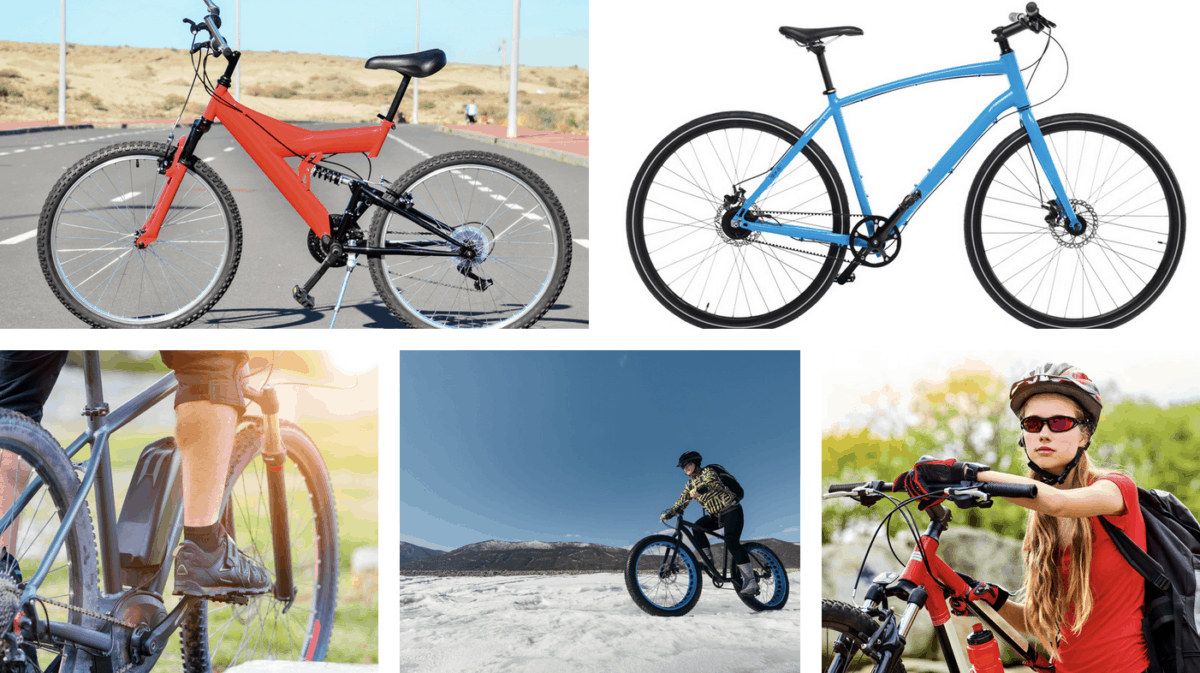You’ve decided you want to get a mountain bike. Congrats! As you begin doing your research though, you realize there’s a lot more complexities to these bikes than you assumed. What are the types of mountain bikes? How do you choose, especially if you’ve never bought one before?
The five types of mountain bikes include:
- Hybrid
- Hardtail
- Full suspension
- Fat tire
- Electric
Do you want to know the differences between each of these mountain bike types, including their pros and cons? If so, then you’ve come to the right place. We’ll explore all five types of mountain bikes in depth, giving you plenty of information. By the time you’re done reading, you should find it easy to pick which mountain bike suits you best. Yes, even if you’ve never bought a mountain bike before.
The Five Types of Mountain Bikes
As we mentioned in the intro, you can choose from five types of mountain bikes. These include hybrid, hardtail, full suspension, fat tire or fatbikes, and electric bicycles. Let’s briefly explain each type of bike now before going into much more detailed explanations in the next section.
Hybrid
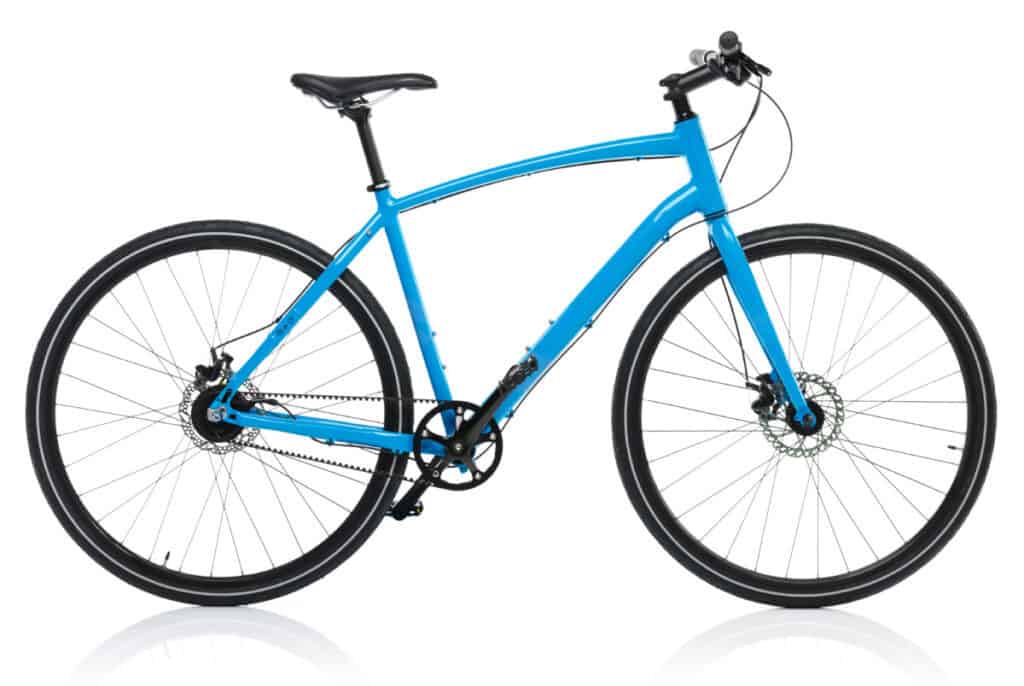
As the name might indicate, a hybrid mountain bike combines the best bike features for riding in many styles and various conditions. Besides mountain bikes, you can also get hybrid touring and road bikes.
The shape and profile of a hybrid mountain bike makes them stand out. These have taller seating like you’d get with most mountain bikes, but with straighter, flatter handlebars. Your bike might have mount racks for bags and cargo, although you’ll find this more with hybrid touring bikes than hybrid mountain bikes.
Going back to their profile for a moment, hybrid mountain bikes also tend to feature smoother tires yet thin wheels. They weigh less compared to other types of bikes as well.
Hardtail

Hardtail bikes have non-suspended rear wheels but front wheels with suspension. They’re pretty much the opposite of full suspension mountain bikes, which we’ll delve into shortly. While hardtail mountain bikes have their place, riders tend to prefer the full suspension version of these bicycles.
That said, hardtail bikes boast amazing efficiency when you pedal, letting you go further on your treks. You will also enjoy less time on maintenance compared to other mountain bikes out there. Another great perk? Hardtail mountain bikes tend to cost less than the other types of bikes we’re featuring in this article.
Full Suspension
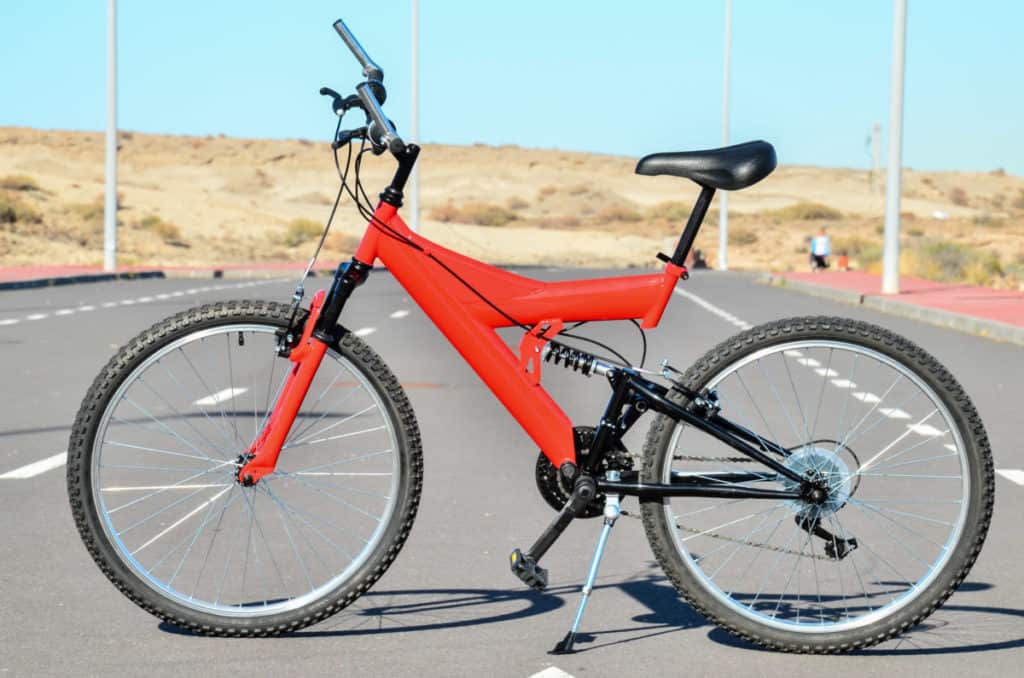
While there existed a time where hardtail bikes outsold full suspension bikes, that’s rarely the case today. That’s because full suspension technology and design has come a long way since the beginning of the 1990s. It was then that mountain bikes had suspension forks but a rather tough, unyielding frame. The design of these bikes at the time allowed full suspension mountain bikes to attain little suspension travel, typically one and a half to two inches of front suspension.
Today, more mountain bikes use Dual Suspension systems, which is the latest in full suspension technology. The rear and front wheels alike have shock absorption. This allows the rear wheels to move more readily as the rider passes along obstacles that the tires might get close to. Overall, you enjoy a riding smoothness not found with suspension mountain bikes in years prior.
While you will spend more money on one of these mountain bikes compared to many others, per the points above, we think these bicycles are quite beneficial. Do keep in mind that full suspension mountain bikes may have less pedaling efficiency compared to other bike types, especially hardtails. They also tend to weigh more.
Fat Tire
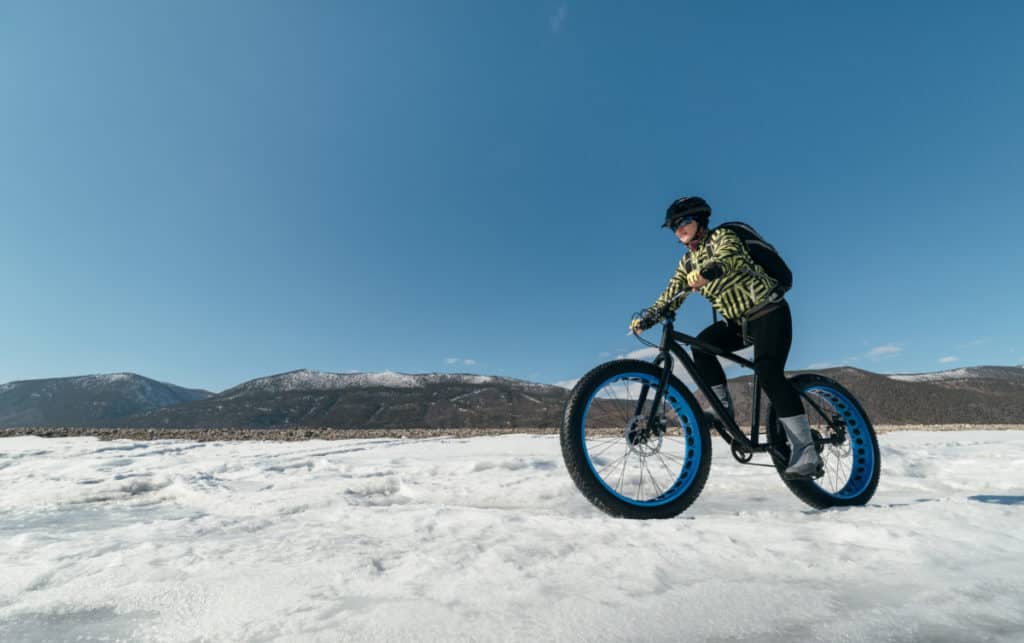
Fat tire mountain bikes or fatbikes earned that name due to the oversized nature of their tires. These bikes must have rims measuring 2.16 inches or greater and tires that are 3.8 inches or more. The size of these tires allows fatbikes to achieve a much lower degree of ground pressure than other mountain bikes. If you’re interested in off-roading, you’d want to take this bike with you.
When you inflate a fatbike, you actually want a much lower pressure in pounds per square inch or PSI than usual. You should try to stick to around 5 PSI, 0.34 bars, or 340 hectopascal pressure or HPA. You can exceed this pressure to 10+ PSI if necessary.
Electric
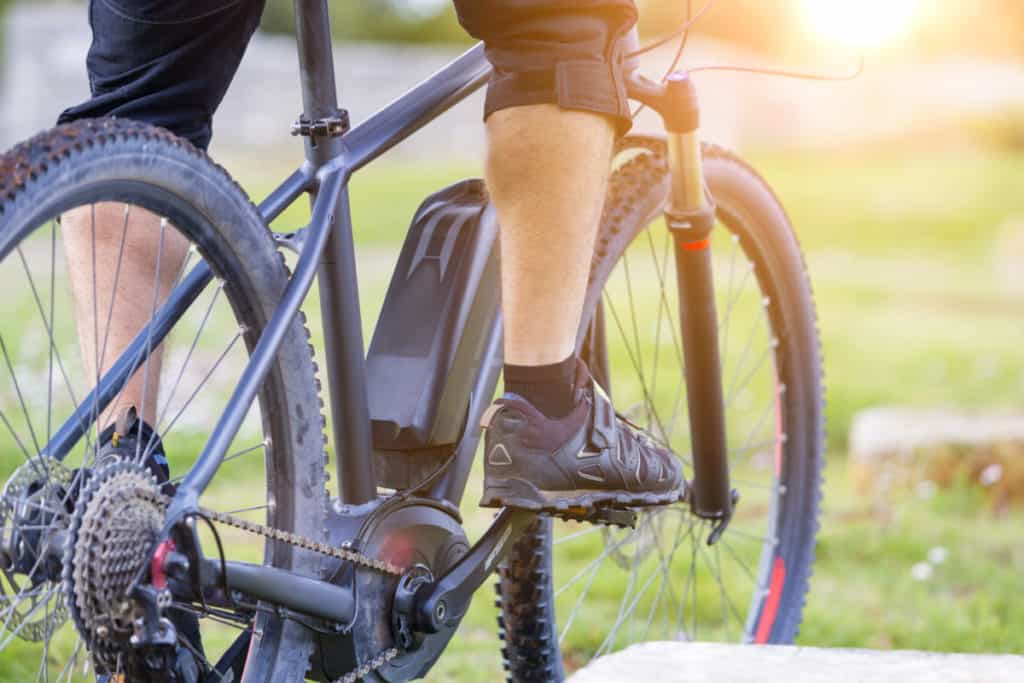
Last but certainly not least, you might want an electric mountain bike or an e-bike. Sometimes these bikes rely on your pedaling to generate power. If so, these bikes are called pedelecs. Others have motors that allow you to ride without pedaling.
While they don’t get a significant max speed (up to 20 miles per hour or MPH usually), you can potentially get a faster e-bike. This might hit 28 MPH. However, depending on where you go, certain laws may prohibit you from riding an e-bike that can achieve that speed. Also, many land management regulators have prohibited e-bikes from mountain bike trails. They have concerns about trail damage from e-bikes, even if those claims remain unproven.
To charge your electric mountain bike, you only need to power up the batteries. You can then recharge and recharge as much as necessary.
Hybrid Bikes: An Overview
Okay, now that we’ve briefly talked about each of the five types of mountain bikes, it’s time to dive into more specific info for each bicycle. Let’s begin with hybrid mountain bikes and work our way down through each type from there.
The Terrain It’s Best for
Since manufacturers often convert hybrid bicycles into mountain bikes, touring bikes, and road bikes, they’re quite versatile. In fact, some bike enthusiasts even call hybrid bicycles “general purpose” for that very reason.
While we wouldn’t recommend riding a hybrid touring bike or a hybrid road bike on a mountain trail, that’s obviously not true for hybrid mountain bikes. These have the body design and the tires to handle rocky, mountainous terrain and its sudden, sharp turns.
Types of Riders Best-Suited for
The great adaptability of hybrid bikes makes them perfect for riders of all ages, including children, teens, and adults. Those who lack experience should also find navigating paths on a hybrid bicycle pretty easy. Even commuters favor these bikes.
If it’s hybrid mountain bikes we’re talking about, then we’d keep the kids and inexperienced riders off the path.
Performance
Remember that hybrid mountain bikes often have thin wheels and a lightweight frame. That provides these bikes with a smoother riding experience than you’ve perhaps ever enjoyed on a mountain bike before. You don’t have to worry about bumping along the trail and absorbing each shock as you go.
Not only that, but the tires lend themselves well to making less effort when riding. That means you can take your biking adventures further and go longer without tiring yourself out. You’ll also achieve greater speeds thanks to the design of hybrid mountain bikes.
The positioning of the seat and handlebars also creates a experience many riders quite enjoy.
Our Favorite Hybrid Bike
If you’re looking for a good hybrid mountain bike for yourself, look no further than Vitus’ Mach 3. A favorite since 2015, this bicycle has all the features you’d expect in a hybrid mountain bike, like upright positioning and a flat bar.
The Mach 3 comes equipped with hydraulic disk brakes from Tektro as well as a Shimano Claris/Sora groupset. It has an alloy 6061-T6 frame designed to weigh less so you can ride more. The T700 HM-UD fork, which comes carbon-bladed, also has an alloy steerer. Together, both features cut down on road buzz and shocks.
Hardtail Bikes: An Overview
The Terrain It’s Best for
Many hardtail bikes can tow the line between precision and loose riding equally well. Whether you want to cut through a forest with grassy hills and rounded stones or go up in the mountains with jagged, rocky terrain, you can.
Types of Riders Best-Suited for
If you’re only barely familiar with mountain bikes, then you should have an easy enough time adapting to a hardtail. It may take some time, but you’ll get there. Should you ever want to switch to a full suspension bike, you’ll find your adjustment period is much shorter.
Since hardtails stick closer to a mountain bike feel than some of the other bicycles we’ve covered on this list, we wouldn’t recommend it for more casual riders. It’s certainly not a commuter bike like a hybrid.
Performance
The key difference between hardtail and full suspension bikes has to do with their suspension abilities. Hardtail bikes do not have suspension in the rear wheels, only the front. The back wheels stay more rigid and firm, then. As we mentioned before, the front forks provide limited suspension travel, typically an inch and a half to two inches. This is between 38 and 50 millimeters.
Another major difference between hardtail and full suspension mountain bikes? Their pedaling efficiency. Due to their design, hardtail bikes let you go further with less pedaling. That’s not the case with a full suspension mountain bike.
Our Favorite Hardtail Bike
If a hardtail bike calls out to you, try Diamondback’s Sync’r Carbon. The manufacturer calls this model “the most bomber yet of our progressive hardtail mountain bikes.” It comes with a carbon frame with boost rear spacing and a specially-designed headtube. These features allow your Sync’r to ride more stiffly for more control.
The Blanchard wheels feel plush, even as you ride on rocky terrain or hills. The tires measure 27.5 inches by 2.8 inches and come tubeless. Those who want to upgrade to bigger wheels (29 inches) also can.
With the drivetrain from SRAM GX Eagle, riding feels more awesome than ever. You also get hydraulic disc brakes from manufacturer Shimano to help with sudden stops. The Fox 34 Float Performance fork measures 140 millimeters and can aide you in big jumps and cool riding techniques.
Full Suspension Bikes: An Overview
The Terrain It’s Best for
The Dual Suspension feature found in many modern mountain bikes gives them the freedom to ride along obstacles and all sorts of terrain. This includes even rough terrain like dirt or stone paths that you might find on some trails. One of these bikes can even handle hills quite adeptly, so feel free to ride to your heart’s content.
Types of Riders Best-Suited for
As a step up from hardtail bikes, we’d once again say that those serious about mountain biking should attempt riding on a full suspension bike. With all their features for terrain and hills, there’s no need to waste this bike as a commuter or city bicycle. Sure, it could serve those purposes, but that’s not why these babies exist. They’re meant for tricky riding on all sorts of trails and paths.
Performance
Unlike their hardtail counterparts, full suspension mountain bikes with Dual Suspension have rear and front wheel shock absorption. We mentioned this earlier in this guide. The wheel connects right to the bicycle frame, offering even greater absorption from impacts.
When riding on uneven terrain or down hills, most of the time, the front wheels will bounce. This occurs especially if you hit something, such as a rock. As the energy from your bike propels to the front tire that’s bounced, your speed drops. That’s just energy and physics in action.
Dual Suspension mountain bikes will take the force from the front tire bouncing and pass it to both the rear and front wheel shocks. This keeps your momentum going forward rather than up and does not mess with your speed at all.
However, you may notice that on certain trails and roads, this bike doesn’t perform as well as it does on terrain and hills. That’s because, as we mentioned, full suspension bikes don’t have the same pedaling efficiency as hardtail mountain bikes. That does depend on the model, though. Others have the same or even better pedaling efficiency. These bikes will always weigh more than their hardtail counterparts, and they cost more, too.
Our Favorite Full Suspension Bike
A full suspension bike we quite enjoy also comes from Diamondback. It’s their Release 3, a good mid-priced option. It has a KS LEV Si dropper post and DHF/DHR tires from Maxxis Minion. You can convert the wheelset from Blanchard to a tubeless variety if you so choose.
Like other Diamondback bicycles, you still get Shimano brakes. This time, it’s their XT hydraulic disc brakes that come outfitted with the Release 3. This full suspension bike also has a drivetrain from Shimano, the brand’s XT, which has 11 speeds.
The rear shock included is a Fox Float DPX2 and the travel fork a Fox 34 Performance Float that’s 150 millimeters.
Fat Tire Bikes: An Overview
The Terrain It’s Best for
If there’s a particular bicycle out there designed for off-roading, we’d have to say it’s the fatbike. In fact, you shouldn’t ride these bikes on the road due to their low tire pressure. As we discussed before, that pressure always stays low. On average, you might fill the tire up to 5 PSI. Depending on the riding conditions, some riders inflate the pressure ever so slightly more to 10 PSI, but rarely higher. That’s 0.55 to 0.69 bar and 550 to 690 HPA.
With that low tire pressure, fatbikes can ride through mud, bogs, sand, snow, and other terrain with aplomb. That said, if you want to hit rocky terrain and hard hills, you might want to consider another type of mountain bike. Fatbikes effortlessly pass through lots of terrain, that’s true, but it must be softer terrain. If it’s hard surfaces, the low pressure of the tires could possibly cause them to pop.
Types of Riders Best-Suited for
Off-road riders looking for a thrill will love fatbikes. You can have some mountain biking experience and you should likely adapt to one of these bikes with almost no difficulty. Those who have used commuter bikes until now might need a longer adjustment period.
Performance
With most fatbikes having a tire pressure of 5 to 10 PSI, these are made for off-roading. They often have tire rims that measure about 55 millimeters or 2.16 inches. The tires themselves are 97 millimeters or 3.8 inches and up.
Most fatbikes have an internal rim width that’s 35 to 50 millimeters or 1.4 to 1.97 inches. Their width varies from 3.5 inches to 5.0 inches. Some fatbikes have Plus tires with a thinner profile and a width of 2.5 to 3.25 inches.
Our Favorite Fatbike
For a great fatbike, try the Farley 9.8, a solid pick from Trek. This dark red bike weighs less than you’d expect, especially for a fatbike. It has a drivetrain from Eagle, the 1×12 SRAM GX. This gives you a stunning array of gears so no matter which terrain you take your fatbike through, you’re ready.
The Farley 9.8 also comes with carbon wheels, a carbon fork, and an OCLV carbon frame that makes it fantastic at navigating mountainous trails.
Electric Bikes: An Overview
The Terrain It’s Best for
The last type of mountain bike we’re going to cover is an electric bike or e-bike. These casual bikes can ride on lots of different terrain, especially considering all the e-bike subtypes. For instance, if you like to go off-roading, you can get an electric fatbike. There’s also electric hybrid bikes and electric mountain bikes as well.
Types of Riders Best-Suited for
You don’t have to have a ton of experience with mountain biking to figure out riding on an electric bicycle. If you go for a power-on-demand version (which we’ll explain in the next section), then you can keep pedaling to a minimum. The bike’s engine does most of the hard work.
Performance
You can choose from two types of electric bikes: power-on-demand and pedal-assist. The power-on-demand e-bike has a throttle you use to start the motor. You hold onto the handlebars and then ride. Then there’s pedal-assist electric bikes. With these, you have to pedal to trigger the electric motor into accelerating. Also referred to as pedelecs, these bikes include built-in sensors. The sensor can read how forceful and fast you’re pedaling for safety’s sake. There’s even brake activation features that can stop the motor from accelerating in certain conditions.
According to a 2010 study called the Life Cycle Assessment of Transportation Options for Commuters, e-bikes double as an eco-friendly option. They provider greater energy efficiency compared to using rail transit (6x), driving a sedan (13x), or driving an SUV (18x).
Our Favorite Electric Bike
Here’s a very cool e-bike from Pedego Electric Bikes. Their Interceptor Platinum Edition has a lot of great features. These include Step Thru or Classic frame style options and several wheel choices. You even get to customize your battery, selecting from a 48-volt 15Ah battery or a 48-volt 10Ah battery.
The Interceptor runs on a 500-watt motor that makes very few sounds. This motor can ascend and descend hills as well as speed up when the need arises. No matter which battery you choose, it has lithium-ion cells like you’d find in an electric car. You can go 60 miles before needing to recharge. That’s the electricity spending equivalent of 10 cents.
When you do need to pedal, you can rely on a drivetrain with 10 speeds. The hydraulic disc brakes have levers for giving you more control. You’ll also find a suspension fork with the Interceptor that can handle bumps without you feeling each impact. There’s even a lockout switch for cutting down on suspension when it’s unnecessary.
How to Choose Which Style of Mountain Bike Is Right for You
Now that we’ve extensively covered all five types of mountain bikes, you have a choice to make. You must decide which type of bike you’ll buy. Each has its pros and cons, but any of the five would make for a phenomenal first mountain bike.
How do you even begin to choose? Here’s some points to keep in mind as you narrow down your options.
Price
Some mountain bike costs less than a thousand dollars, with most more expensive. If you can find a bike for under four figures, then great! However, if the bicycle you like has a heftier price tag, then you’ll probably have to budget.
How much money you have right now to spend on a bike versus how much you might have in a few months is very important to consider.
Purpose/Function
Next, you have to think about what you’ll use your bike for. If you like mountain biking, but only on trails, then you shouldn’t get a fatbike. Not only do these bikes not ride on hard terrain well, but they’re designed for off-roading. If you don’t use a fatbike for off-road adventures, then why even have one?
You want to ensure you get a bike that matches the purpose you plan to use it for. Be honest with yourself for this part. Some people like to go riding every single day, but only on light trips. Others bust out their mountain bikes on the weekends and beat it up. You might fit in either of those camps or somewhere in between.
Regardless of what you like to do on your bicycle, there’s a mountain bike out there for you.
Maintenance
No bike stays in pristine condition without a bit of maintenance. You’ll need to inflate the tires, lube up the chain and other components, clean the seat and handlebars, and maybe even recharge the battery.
You might not love doing bike maintenance, but it’s a crucial part of your job as a bike owner. Certain types of bikes, like hardtails, don’t require extensive maintenance. Other mountain bikes, such as an e-bike, need much more help. You have to charge them, take care of the battery, and constantly check battery levels so you don’t end up stranded on your ride.
If you’re more of a low-maintenance type of person yourself, then make sure you don’t get a mountain bike that requires tons of upkeep.
Features
Finally, let’s talk about features. You should expect disc brakes with your mountain bike, as these come standard. That’s because disc brakes, with their central wheel hub positioning, let you stop on a dime. If you’re on a trail or off-roading, you’ll appreciate that kind of quick stopping power.
You should also get multiple gears and flat handlebars with your mountain bike. If your bike lacks these features, then you might want to keep looking. Not only do these features promote safety while riding, but they’re included with almost every mountain bike.
Conclusion
When choosing a mountain bike, you can select from one of five types. These are hybrid, hardtail, full suspension, fatbike, and electric or e-bikes. While some of these bike types share similarities, there’s enough differences between them that one should suit your needs especially well.
We hope this guide assisted you in choosing a mountain bike. As you buy your first bike, remember to take your time. There’s no rush to find the perfect mountain bike for you. Enjoy the experience and enjoy riding even more! Good luck.

